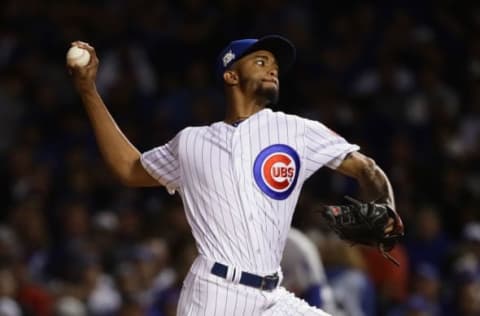Chicago Cubs: Justin Grimm and obsolescence by design


“Bullpen workhorse” is both a compliment and death sentence for pitchers like former Chicago Cubs reliever Justin Grimm. But don’t expect the revolving door of burned-out young arms to end soon.
The Chicago Cubs meticulously manage innings and pitch counts of their high-investment starting pitchers. But with fewer starters league-wide throwing 200 innings, bullpens must cover a continually increasing workload. The result: shorter careers for max-throwing non-closers.
Such was the fate of recently released Justin Grimm. Drafted as a starter in 2010 by the Texas Rangers, Grimm struggled in the minors to average five innings per start. Converted to a max-throwing reliever, he unfortunately lacked the consistency to close, sealing his likely fate as a short-career workhorse reliever.
This was no surprise for Grimm. Longevity and high career earnings belong to effective starters and elite closers. All pro pitchers and their agents know this.
For hurlers of major-league ability, it’s generally less taxing to throw 160-180 innings as a starter than make 60 to 70 irregularly spaced relief appearances. Thus a team feels good to get three or four such seasons out of a reliever, and then onto the next young arm.

Failed starter? Take a shot as a reliever
This is partly why Mike Montgomery vented his desire to either start or be traded. It’s his last season before arbitration. He knows starters are rewarded better in arbitration than swingmen. Plus he’d love three years after that to reach free agency with a bankable arm in tack.
Ironically, the modern draft approach of most major league teams have mostly deepened the downward relief spiral. Drafting and developing players is a costly and risky business, and teams feel they can hedge these by drafting more max-throwing, high-K starting pitchers.
The thinking is, even if they fail as starters, the organization might reap some returns by converting them into shorter-lasting relief assets. Since the goal is getting players to the majors, organizations then feel they get two bites at the apple with a max-throwing prospects.
This, though, has devalued finding and signing the next generation of less injury-prone, innings-eating command pitchers like Mark Buehrle, Andy Pettitte and Greg Maddux. Thus All-Star-quality command pitchers like Kyle Hendricks and the Phillies’ Aaron Nola now seem as rare as knuckleballers.

Heavier workloads for relievers
By comparison, fire-balling starters typically will burn brighter but not as deeply into games. This means for every extra max-thrower added to a rotation, the innings burden grows further on all those failed converted max-throwing relievers. (And if a starter goes down with injury, the burden gets heavier still.)
More from Cubbies Crib
- Cubs should keep close eye on non-tender candidate Cody Bellinger
- Cubs starting pitching has been thriving on the North Side
- Make no mistake: the Cubs are very much about power hitters
- Cubs are giving pitcher Javier Assad a deserved shot
- Cubs: It’s time to start thinking about potential September call-ups
Stats bear this out. Last year, major league bullpens averaged a record-setting 549 innings. This is up more than 8% since 2008 and nearly 14% since 2000 (483 innings). With each bullpen inning representing roughly one appearance, that’s a lot of extra work to spread around the ’pen.
Consequently, most teams now have at least five relievers making 60 or more appearances a season. This included the Cubs last year: Carl Edwards, Brian Duensing, Pedro Strop, Hector Rondon and Grimm (including his minor league work).
Wade Davis also fell one game short of 60. However, his workload as closer was inherently not as great for several reasons.
For one, closers (and exclusive 8th inning set-up men) are stronger, more effective and more pitch-efficient pitchers. That’s why they won the closer spot. Two, non-closers must warm-up quicker, on shorter notice and sometimes multiple times before entering. Three, once a closer warms up, he almost always enters the game. Such is not the case with workhorse relievers, and those non-appearances add invisible wear and tear not in the box score.

Is it time to safeguard reliever’s arms?
In Grimm’s case, he appeared in 73 games his rookie 2014 season. He followed up with a terrific 2015, posting a 1.99 ERA and 12.1 K/9 innings in 62 appearances. Thereafter, he had two largely ineffective seasons of 60-plus appearances. Then his release this spring.
Ideas have been floated to protect and extend the careers of relievers like Grimm. This includes rules to inactivate a reliever for one game after being warmed up two consecutive days or prohibiting any reliever from being thrown four times in five days.
One pace of play idea floated would limit the number of mid-inning pitching changes a manager can make. This would reduce the overall number of relief appearances and in turn provide relievers more recovery time.
As 30% of union members pitch out of a bullpen, you’d think this would be a nice win-win to shorten games and meet the union’s primary goal to protect the health and earning potential of its members. But so far, no bites.
Next: Looking back at the Matt Garza trade
Not to pity Justin Grimm too much. Another team may pick him up. Also, including his $600,000 guaranteed this year and his $825,000 draft bonus, he’s made made more than $3.3 million from his arm in eight years. That’s far more than I’ve gotten out of any of my body parts yet.